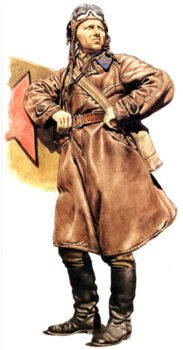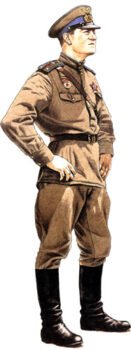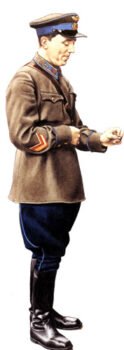WW2 Red Army Uniform Guide

The soviet pilot is wearing a pre-war leather flight coat and genuine leather flight helmet. Pay attention to the signs on the buttonholes. Junior officers wore red enamel squares (lieutenant – two squares) and an emblem – a propeller with wings.
By the time the Germans invaded the territory of the USSR, the Red Army Air Forces were undergoing a painful reorganization; the commanders tried to find ways to improve their combat effectiveness compared to the miserable state they had shown during the “winter war” against Finland. Aviation was unprepared for combat, and therefore the Germans on the very first day of the invasion managed to destroy 1489 Soviet aircraft on the ground and 322 in the air while losing only 35 of their aircraft. Unfortunately, these losses were only the beginning of the route.
During the war, the Germans continued to inflict heavy losses on Soviet aviation. Even in air battles, the Red Army Air Force could not be compared with the Luftwaffe. By the end of November 1941, the Germans claimed to have destroyed 16,000 Soviet aircraft, losing 3,453 of their aircraft killed or damaged.
The winter of 1941/42 gave the Russian Air Force a break, as a result of which they turned out to be better than the revolution, trained their pilots to fly on new forms, such as the Il-2 attack aircraft and the Yakovlev and Lavochkin fighters. In addition, the aviation industry was relocated to the East, mainly to the Urals, out of the reach of quality bombers.

WW2 Red Army Uniform
The new rules for wearing uniforms, adopted on January 6, 1943, made many changes to the uniforms of the officers of the air force. In particular, new tunics and tunics were introduced, on which there were more obvious signs of difference: all employees received chase signals for full dress and everyday uniforms and cloth ones for field uniforms.
Field epaulets had blue edging and one or two dark red gaps. Junior officers, such as this lieutenant, had one lumen and one to four silver stars with a diameter of 13 mm. The ceremonial tunic had buttonholes and a double edging on the cuffs.
The buttonholes were blue with one or two embroidered stripes, according to belonging to the senior or middle command staff, which was also shown by the double edging of the cuffs.
On the right side of the chest, this officer has a Guards badge and stripes for wounds introduced in July 1942. On the left side of the chest, there is the Order of the Red Star.
WW2 Red Army Uniform of Officers

WW2 Red Army Uniform – Officers
The Soviet Air Force was not an independent branch of the armed forces but was part of the Red Army as a branch of service. In August 1924, the aviators received blue uniforms, and in December 1935 they were declared to be every day, full dress and full dress uniforms. The basic uniform in the Air Force was the same as in the ground forces, differing only in blue buttonholes and piping. Later, this color was transferred to the shoulder straps of aviators.
In 1935, the Soviet Air Force received new buttonholes with a blue field and gold piping for officers and black for political workers, soldiers, and junior commanders. On the buttonholes were placed the emblem of aviation – a propeller with wings – and insignia in the form of red enamel rhombuses, rectangles, squares, and triangles, introduced in 1924.
The gold and red chevrons shown in the illustration were introduced for the Soviet Air Force in 1935 and changed in 1940. Initially, only generals wore gold chevrons, and other officers wore red chevrons, but in 1940 generals were given one wide gold chevron with a narrow red stripe at the bottom and a golden star at the top. The chevrons assigned to officers consisted of a combination of gold and red stripes.
This shirt of the WW2 red army uniform you can purchase here: WW2 Red Army Uniform
This is example video : Soviet Uniforms 1939-1945

